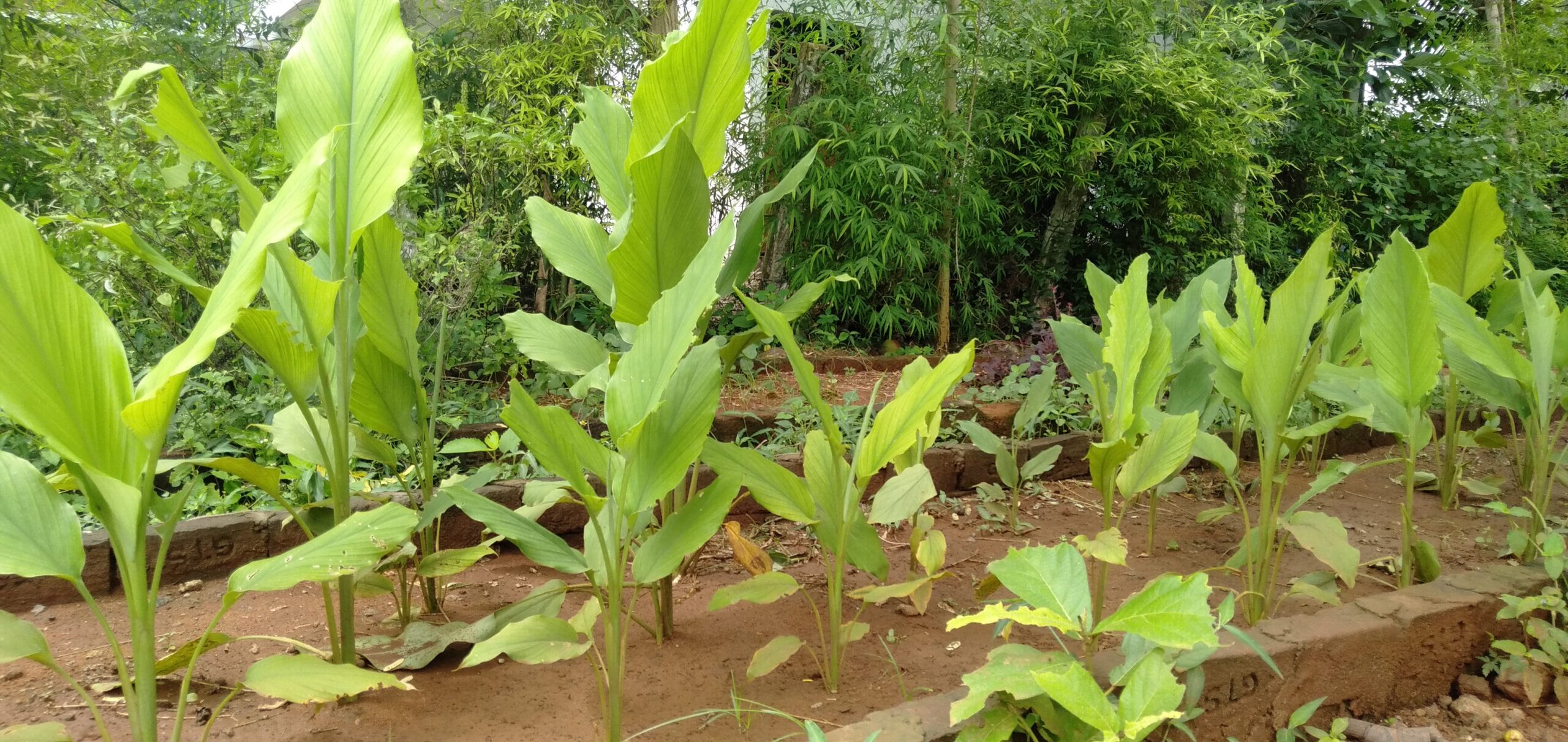If you have any questions regarding processing turmeric, look no further. You have come to the right place. I was looking for answers myself and never found it, so I decided to find it out for myself. If you have questions like;
Then, this post and the video I am sharing will answer all of these questions. Let’s start at the very beginning…
It was last year in January. We were packing up to travel to our native place for Pongal celebration. On the way we were planning to stop at our farm and gift new dresses to our farm workers and then carry on forward on our journey. As the car rolled by I noticed the markets flooded with sugarcane, earthen wares and various special festival items and something caught my eye – TURMERIC! And there were loads of them on display. In a flash I had realized that I had been waiting for this season to get these rhizomes forever! I had to act fast. I asked my husband to pull the car over to buy some of them to plant them on my farm. I knew it was now or never; because if I miss this opportunity, I will have to wait another whole year to start growing them. The rest as they is history…haha!

But when it came to processing the turmeric, I was at loggerheads as there were conflicting thoughts about processing it. So I was stuck at a particularly tough decision – to boil or not to boil! Wondering what I am talking about. Well, check out the video where I finally discover for myself which is the best way to process turmeric; at least for me.
Watch this video to see how we planted, harvested and processed these beauties! And to know all the details about how to grow them, continue reading.
Benefits of Turmeric:
Ok, so, Turmeric, known as Manjal in Tamil and haldi in Hindi, is a popular spice. Botanically called Curcuma longa, turmeric belongs to Zingiberaceae family- the same family as ginger. You won’t find any household without a bottle or two of these in powdered form because we Indians put this in literally every curry/gravy/ and anything else. We love it too much. It’s used as a condiment, dyeing agent, flavoring agent and as a medicine too! Turmeric is known for its anti-inflammatory, antiseptic and antiviral properties. The curcumin compound is well known for curing cold, cough and chest congestion. Studies show that it prevents cancer, Alzheimer, heart diseases and many other illnesses.
Apart from the culinary and medicinal aspect, this spice has a significant cultural importance attached to it too. No auspicious ceremony or festival in Hindu religion is complete without its prominent presence! Let’s say it is a sacred spice of India.
Important points to remember about Turmeric Growing:
First of all, let me encourage you by saying that this is an easy, low maintenance crop. You should definitely try it even if in just one container or a very small space. Let’s check the list of things to keep in mind before you start.
1.Climate
Turmeric needs a warm, humid climate for growth. It grows very well in Chennai for sure. The ideal temperature ranges between 25 – 35 degree Celsius.
2.Soil
Though a well-draining soil mix is the best, clayey soil with a large amount of humus works really well for growing turmeric. My farm soil is pre-dominantly clayey and I have been amending it with lots of compost and mulching. That really worked well for growing turmeric.
It is also important to feed your soil intermittently with organic manure as this is a 10 month to a one year crop. The soil needs to be rich in nutrients for the plants to grow well.
3.Sowing/planting
When sowing the rhizomes there should be minimum space of 5 inches between two rhizomes. You can grow many crops in a small space and they grow very well together.
4.Sunlight
Sunlight is very essential as for every vegetable crop. Pick a spot that gets a minimum of 5-6 hours of direct sunlight.
5.Water
Turmeric needs a good amount of water to grow nice and big rhizomes. Make sure to give them enough drink of water every day.
Harvesting of Turmeric
Turmeric is usually ready for harvest within 10 months to a year of sowing. They are ready for harvest when the leaves and stem start turning brown and dry up progressively. I harvested mine after a year as my plants didn’t show signs of drying up. I waited only until the leaves started yellowing and harvested them. I got a pretty good yield for a small patch I planted.
You then dig up the area around each plant and pull out the rhizomes. The extraction can be done by hand-picking if it’s in containers or you can use a spade to carefully lift the clumps up without damaging the rhizomes.
Once you have dug out every bit of turmeric, make sure you wash the rhizomes thoroughly to remove all the mud and other impurities. You might have to wash them 4-5 times until the water you are washing in comes out clean. This is a very important step as these are dug from under the ground and there could be a lot of minute particles of mud sticking to it.
Processing Turmeric:
Once you have washed and dried the turmeric, you can make turmeric powder and store it for a year or more. I have shared a detailed video on how I tried it two ways – the boiled and the raw method. You will find all the details in this video where I am bursting some common doubts surrounding the processing of turmeric. So don’t miss it!
So, I hope you got a fair idea about growing and harvesting turmeric. Don’t wait any longer and try growing them soon and reap the benefits!
Drop in your comments and questions below and I will get back to you soon.

WhatsApp us
Comments
I love the way of narrative explanation you giving all the time. Nice.
Thank you so much. So glad you liked it.
In market we get whole dried rhizomes and they are without skin. But you had mentioned that we have to chop them before drying. Can’t we dry the whole turmeric?
Dried rhizomes can’t be germinated Archna. Only freshly uprooted rhizomes can be used for seeding purposes. Dried whole ones are for grinding into turmeric powder or for making other spice mixes. That CAN NOT be used. Hope it’s clear.
Hey thanks for the information. Great job done.
But what exactly is bad in sundrying the turmeric? if it is the only way to take for me. Do the properties of it get significantly degenerated in sunlight?
(I need to figure this out URGETNLY, as I have dug up a bucket of turmeric which need to be processed into powder. I don’t have a food dehydrator.)
So sorry for the late reply. I know it is redundant to reply now but I don’t know how I missed your comment. No harm in sun drying. Please go ahead with whatever is feasible for you. So happy for your harvest. Wishing you many more abundant harvest in future. Once again apologies for delayed response…
Thank you for the info. I live in cold climate. So I am trying to grow tumeric in pots. Plants came out very good. Now I am going to harvest and process it raw way…because I think it saves time and keeps the herbal essence intact. I am a great fan of herbal medicines. I would like to grow ginger too.
Keep up your good work because it saves money, keeps good organic quality and create public information.
Do we have to leave the rhizomes in ground after all the leaves are dried up?
If yes then for how much time? And do we have to water the soil during this period?
Thanks for your response. My problem is that before the leaves yellowing the tubers start showing new white nodes ready to regrow. Any advice.
Kind regards
You are so eloquent in your description Mam ,I read and watched your entire narrative very keenly. I was spurred to grow turmeric myself and have planted 25 Kg rizhomes on my farm in Uttarakhand. I am staying in Delhi.I don’t have the enviable patience that you have .I want guidance from you regarding when to harvest the crop when it completely dries off and wilts on its own or earlier in 9 months as you did.I planted in May this year, when should I expect the Crop ready for harvest.Please suggest.Thanks and best of luck for your future endeavours.
HI! The leaves are huge! what variety is it?
I planted them this year but only in 5 months the leaves are drying out!
What if you don’t harvest the tumeric? My plant came as a gift and it needed harvesting then but I didn’t have any experience and I cut it down to the root and left. Now a year later it has grown again and the leaves are starting to droop and yellow. I should harvest it now but will it be okay? Should I save a piece to replant?